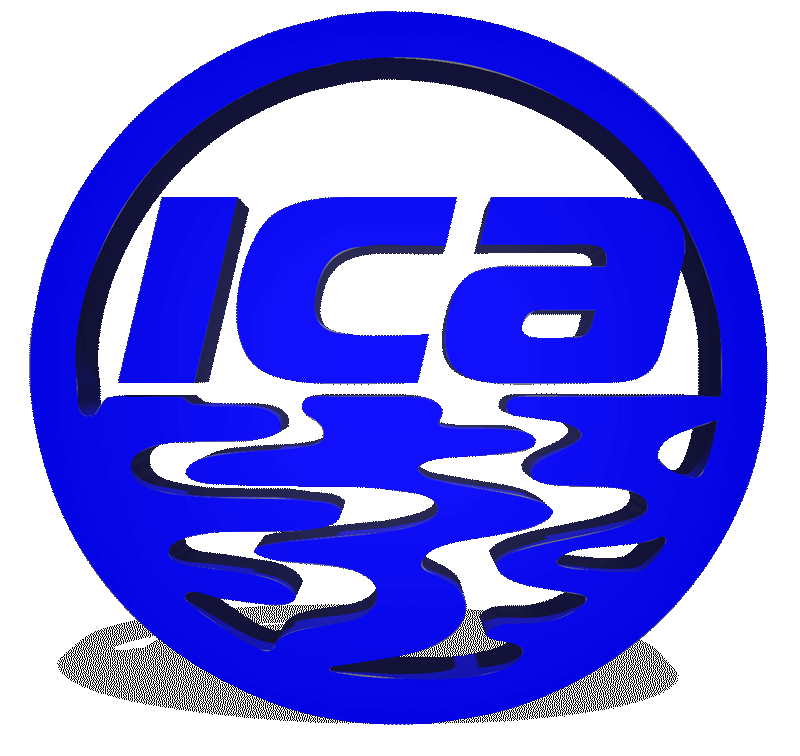


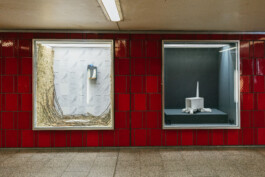
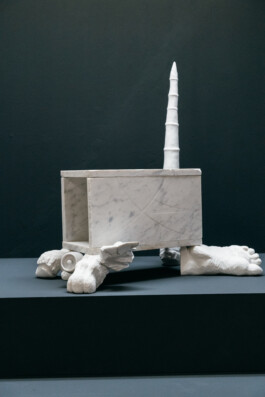
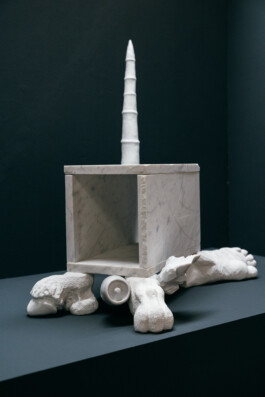
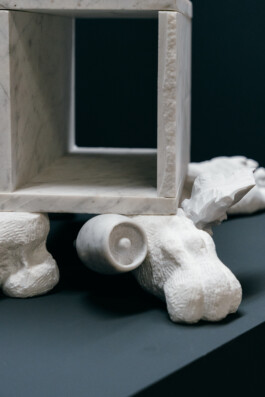
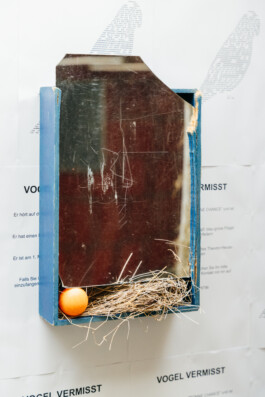

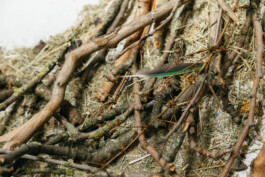
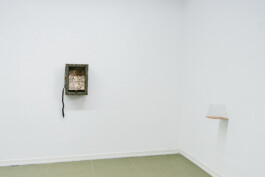
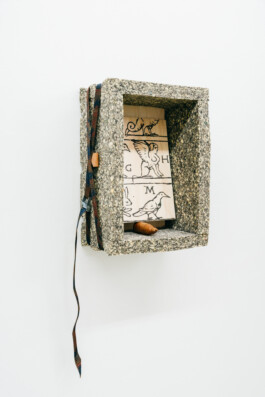
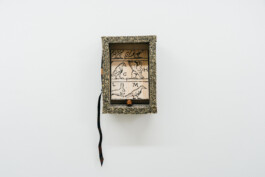
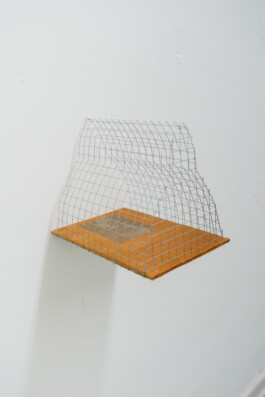
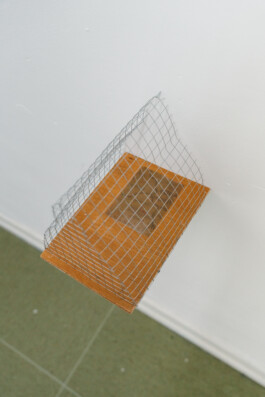
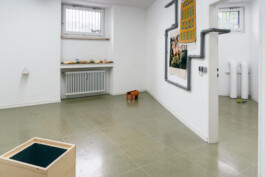
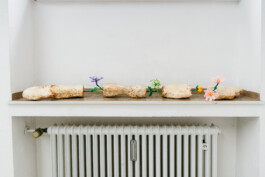
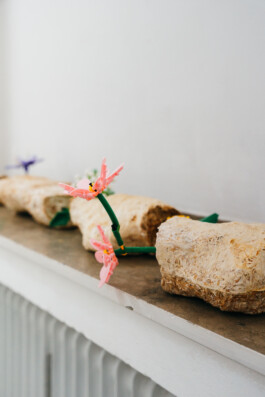
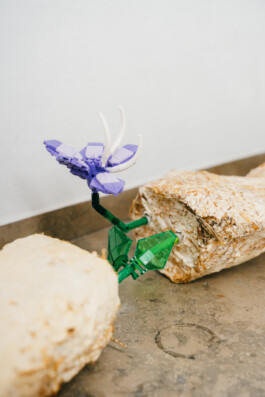
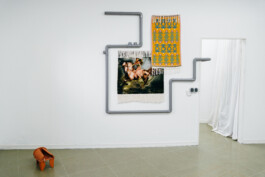
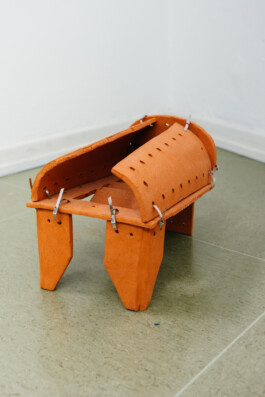
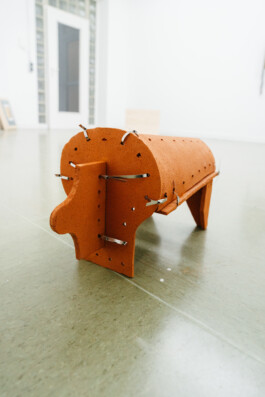
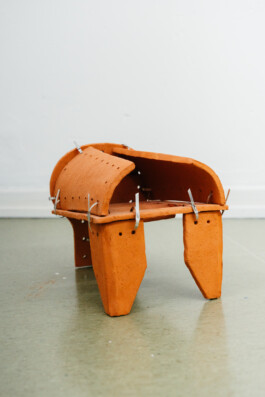
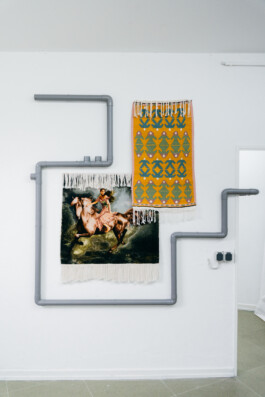
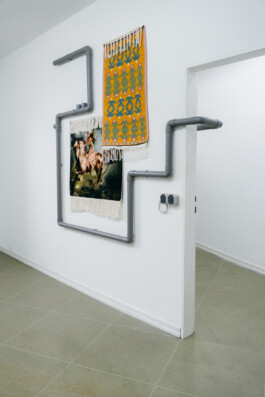
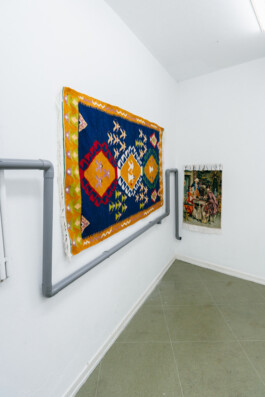
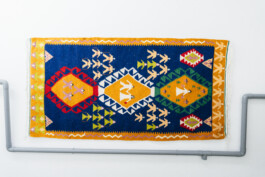
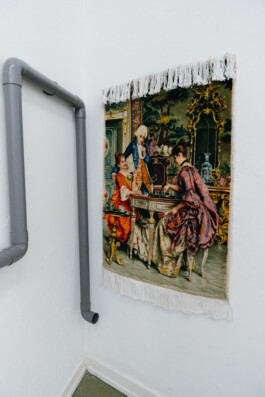
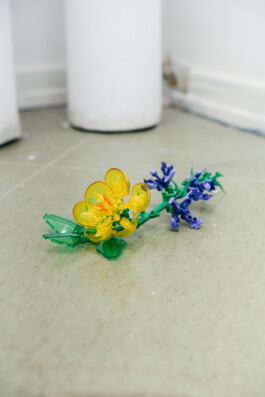
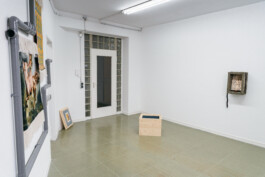
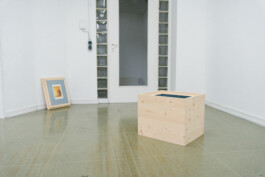
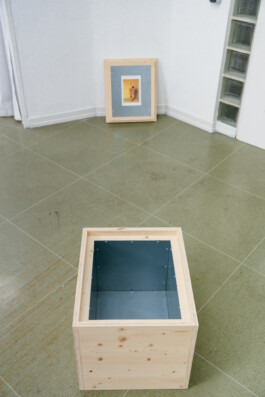
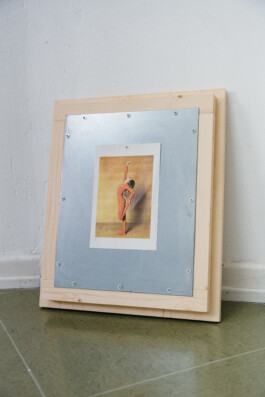
The two exhibitions, Cul-de-sac at Alte Tankstelle Deutz 29/05 -29/06, and Cul-2-sac at ICA 19/06-17/08 include the works of:
Golnesa Rezanezhad (IR–BE) presents a textile installation, titled Weaving the Past into the Present, in collaboration with local rug weavers from northern Iran, her land of origin, Through this work, she wants to subvert the stereotypical representations and perceptions about Middle Eastern women, especially Iranian women, often framed through a Western colonial lens as passive or oppressed, Through traditional craft practices, she highlights how the female weavers imagine and reflect their perceptions about their womanhood and their agency in transforming Iran’s visual heritage—resisting both state-driven heritage preservation and global demands for ‘authenticity' of Iranian carpet and the Iranian woman identity.
She also shows drawings that reflect the shifts brought about by Iran’s transition from an agricultural and craft-based economy to an oil-based one, This transformation deeply affected everyday life—reshaping relationships between people and nature, Within this context, women’s roles and daily practices have been significantly altered, questioned, and challenged.
Adler Murada's (BR-BE) contributes with a film and sculptural pieces that reflect his ongoing exploration from encounters with both human and non-human species, tracing a web of associations linked to language, exile, and childhood, In Parakeet Chronicles, Murada intertwines personal narratives with documentary elements to trace the presence of non-native parakeets in Brussels, The film operates as a poetic inquiry into themes of origin, migration, exoticism, and belonging—where fact and fabulation blur. Alongside the film, Murada presents sculptural works that echo the forms of nests, playgrounds, and shipping containers, using these structures as material metaphors to question captivity, adaptation, and shelter, Through gestures of mimicry, repetition, and interruption, the pieces explore the tension between the intimate and the estranged, the domestic and the displaced.
By pairing natural histories with personal ones, Murada’s work resonates with the exhibition’s question fixed binaries—guest and intruder, native and outsider, Rather than defining belonging, these works suggest a more fluid ecology of proximity and distance, where presence is constantly renegotiated, and even a fractured sound becomes a form of remembering.
Martijn Petrus’ (NL-BE) multidisciplinary practice plays with and comments on how we relate to the idea of nature, by researching topics like paleontology, queer ecology, interspecies kinship and contemporary lifestyle, The series of works made for the two exhibitions in Cologne, feature a strange combination of materials, Flower puzzles, built from colorful parts and sculptural elements built from mycelium, the threadlike network of fungi, The plastic flowers are loosely based on recognizable commercial varieties like orchids, hydrangeas and violas—standardized icons of beauty, desire and domestic exoticism, But these petrochemical flowers, despite their childlike innocence, are ghosts of the deep-time past and mirror the complex realities of the contemporary flower industry, Symbolizing our urge to control life and our relentless desire for beauty, cultivated flowers have become icons of human engineering: designed, bred, and grown to meet our ideals of perfection.
The collages "Protocols of desire (Dupes)" in the first exhibition show parts of the visually descriptive manuals from the toy-flowers, They have a similarity to scientific botanical illustrations, where plants and flowers are dissected and categorized into different elements in order to understand their inner workings and structure, Framing these artificial flowers, both with the collages as with the sculptures, are structures grown from mycelium, Fungi have become the latest addition to the list of eco-trends, celebrated as nature’s hidden heroes—healers, recyclers, connectors, But proposing them as the saviour of the planet is a method that once again takes away our personal responsibility to change the way we interact with our environment.
Mathias Prenen’s (BE) Industria series explores local material agency through the everyday and historical use of ceramics, Developed during a residency in Andalusia, Spain, the project was inspired by the region’s ceramic culture—where clay objects are common, functional, and made for durability and practicality.Collaborating with neighbours and sourcing and processing the clay directly from the land, the artist formed a direct, intuitive relationship with the material, uncovering its long-standing role in storing, directing, and generating both physical and spiritual energy.
In Undermining, Lucy Lippard writes: “The land carries stories as well as stones.”Using pierced and zip-tied ceramic forms, Industria becomes a semi-modular system that merges ancient knowledge with contemporary construction methods, It leans into the interpretive spirit of archaeology and proposes new ways of rebuilding knowledge and meaning through fragments, speculation, and play, This playful reconstruction resists fixed hierarchies and invites collective, imaginative engagement with the past and future, In doing so, the work speaks to decentralized ways of being, offering a material-based, relational approach that challenges rigid binaries and dominant narratives about progress and design, It celebrates the intelligence of materials and the everyday ingenuity found in local traditions, The photographs and ceramic constructions reflect on the tension between archaeological excavation and industrial extraction—one careful and interpretive, the other exploitative and utilitarian.
Maud Gourdon (FR-BE) constructs her Orgone Accumulators in accordance with the principles laid out by Austrian psychiatrist Wilhelm Reich (1897–1957), Rooted in historical controversy and metaphysical speculation, the orgone accumulator embodies a central paradox: a sealed, isolating structure conceived to attract and concentrate a universal life force — the elusive orgone, Positioned between scientific object and symbolic device, it interrogates the boundaries between knowledge and belief, legitimacy and taboo. Reich’s theories and inventions, long marginalized by mainstream science, have continued to resonate as forms of intellectual and political dissent, The orgone accumulator was conceived as a means to enable individuals to liberate themselves from societal repression and restore their natural vitality, which Reich viewed as intrinsically linked to sexuality, For Reich, sexual liberation was not merely personal but a political act, challenging societal control over sexuality, Within this context, the accumulator appears not only as a tool of speculation but also as a place where the contradictions of freedom are materially enacted.
Together, these works form a living archive—a collective, open-ended narrative that resists closure. The exhibition does not offer solutions but rather proposes gestures of interdependence, it asks: What tools do we carry in our shared carrier bag? How might we gather, not to dominate or resolve, but to sustain, share, and reimagine?
In Kollaboration mit Level Five (Brüssel) & Alte Tankstelle Deutz (Köln)
mit freundlicher Unterstützung druch
Stadt Köln, Kulturamt – Flanders, State of the Art
Die beiden Ausstellungen Cul-de-sac in der Alten Tankstelle Deutz (29/05 - 29/06) und Cul-2-sac im ICA (19/06 - 17/08) umfassen Werke von:
Golnesa Rezanezhad (IR-BE) präsentiert eine Textilinstallation mit dem Titel Weaving the Past into the Present (Weben der Vergangenheit in die Gegenwart), die sie in Zusammenarbeit mit lokalen Teppichweberinnen aus dem Nordiran, ihrem Herkunftsland, geschaffen hat. Mit dieser Arbeit möchte sie die stereotypen Darstellungen und Wahrnehmungen über Frauen im Nahen Osten, insbesondere iranische Frauen, untergraben, die oft durch eine westliche koloniale Linse als passiv oder unterdrückt dargestellt werden, Anhand traditioneller Handwerkspraktiken zeigt sie auf, wie sich die Knüpferinnen ihre Vorstellungen von ihrem Frausein vorstellen und reflektieren und wie sie das visuelle Erbe des Irans umgestalten - und sich dabei sowohl der staatlich verordneten Denkmalpflege als auch den globalen Forderungen nach „Authentizität“ des iranischen Teppichs und der Identität der iranischen Frau widersetzen.
Sie zeigt auch Zeichnungen, die die Veränderungen widerspiegeln, die der Übergang des Irans von einer landwirtschaftlichen und handwerklichen Wirtschaft zu einer erdölbasierten Wirtschaft mit sich brachte. Dieser Wandel hatte tiefgreifende Auswirkungen auf das tägliche Leben und veränderte die Beziehungen zwischen Mensch und Natur.
Adler Muradas (BR-BE) Beitrag besteht aus einem Film und skulpturalen Arbeiten, die seine fortwährende Erforschung von Begegnungen mit menschlichen und nicht-menschlichen Spezies widerspiegeln und ein Netz von Assoziationen aufspüren, die mit Sprache, Exil und Kindheit verbunden sind. In Parakeet Chronicles verwebt Murada persönliche Erzählungen mit dokumentarischen Elementen, um die Anwesenheit von nicht-einheimischen Sittichen in Brüssel nachzuzeichnen.
Parallel zum Film präsentiert Murada skulpturale Arbeiten, die die Formen von Nestern, Spielplätzen und Schiffscontainern aufgreifen und diese Strukturen als materielle Metaphern nutzen, um Gefangenschaft, Anpassung und Schutz zu hinterfragen. Durch Gesten der Mimikry, Wiederholung und Unterbrechung erkunden die Arbeiten die Spannung zwischen dem Vertrauten und dem Entfremdeten, dem Heimischen und dem Vertriebenen.
Indem Muradas Arbeiten natürliche Geschichten mit persönlichen Geschichten verbinden, schwingen sie mit der Frage nach festen Binaritäten - Gast und Eindringling, Einheimischer und Außenseiter - mit, die die Ausstellung aufwirft. Statt Zugehörigkeit zu definieren, suggerieren diese Arbeiten eine fließende Ökologie von Nähe und Distanz, in der Präsenz ständig neu verhandelt wird und selbst ein gebrochener Klang zu einer Form der Erinnerung wird.
Martijn Petrus' (NL-BE) multidisziplinäre Praxis spielt mit und kommentiert, wie wir uns zur Idee der Natur verhalten, indem er Themen wie Paläontologie, Queer-Ökologie, Interspezies-Verwandtschaft und zeitgenössischen Lebensstil erforscht. Die Serie von Arbeiten, die für die beiden Ausstellungen in Köln entstanden sind, weist eine seltsame Kombination von Materialien auf: Blumenpuzzle aus bunten Teilen und skulpturale Elemente, die aus Mycelium, dem fadenförmigen Netzwerk von Pilzen, gebaut sind, Die Plastikblumen basieren lose auf bekannten kommerziellen Sorten wie Orchideen, Hortensien und Veilchen - standardisierte Ikonen der Schönheit, der Sehnsucht und der häuslichen Exotik. Aber diese petrochemischen Blumen sind trotz ihrer kindlichen Unschuld Gespenster einer längst vergangenen Zeit und spiegeln die komplexen Realitäten der heutigen Blumenindustrie wider: Sie wurden entworfen, gezüchtet und angebaut, um unseren Idealen von Perfektion zu entsprechen.
Die Collagen „Protocols of desire (Dupes)“ in der ersten Ausstellung zeigen Teile der visuell beschreibenden Handbücher der Spielzeugblumen. Sie haben eine Ähnlichkeit mit wissenschaftlichen botanischen Illustrationen, bei denen Pflanzen und Blumen seziert und in verschiedene Elemente kategorisiert werden, um ihr Innenleben und ihre Struktur zu verstehen, Sowohl bei den Collagen als auch bei den Skulpturen rahmen Strukturen aus Pilzmyzel diese künstlichen Blumen ein. Pilze sind der jüngste Neuzugang auf der Liste der Öko-Trends, die als verborgene Helden der Natur gefeiert werden - als Heiler, Recycler, Verbinder... Aber sie als Retter des Planeten vorzuschlagen, ist eine Methode, die uns wieder einmal die persönliche Verantwortung dafür abnimmt, wie wir mit unserer Umwelt umgehen.
Mathias Prenens (BE) Industria-Serie erforscht die lokale Materialkompetenz durch die alltägliche und historische Verwendung von Keramik. Das Projekt entstand während eines Aufenthalts in Andalusien, Spanien, und wurde von der dortigen Keramikkultur inspiriert, in der Tonobjekte alltäglich, funktional und auf Langlebigkeit und Zweckmäßigkeit ausgelegt sind. Durch die Zusammenarbeit mit Nachbarn und die Beschaffung und Verarbeitung des Tons direkt vor Ort baute der Künstler eine direkte, intuitive Beziehung zu dem Material auf und entdeckte dessen langjährige Rolle bei der Speicherung, Lenkung und Erzeugung von körperlicher und geistiger Energie.
In Undermining schreibt Lucy Lippard: "The land carries stories as well as stones." Es lehnt sich an den interpretierenden Geist der Archäologie an und schlägt neue Wege vor, Wissen und Bedeutung durch Fragmente, Spekulationen und Spiel wiederherzustellen. Diese spielerische Rekonstruktion widersetzt sich festen Hierarchien und lädt zu einer kollektiven, fantasievollen Auseinandersetzung mit der Vergangenheit und der Zukunft ein, indem sie Die Arbeit spricht dabei dezentralisierte Seinsweisen an und bietet einen materialbasierten, relationalen Ansatz, der starre Binaritäten und vorherrschende Erzählungen über Fortschritt und Design in Frage stellt. Sie feiert die Intelligenz von Materialien und den alltäglichen Einfallsreichtum, der in lokalen Traditionen zu finden ist. Die Fotografien und keramischen Konstruktionen reflektieren die Spannung zwischen archäologischen Ausgrabungen und industrieller Gewinnung - die eine sorgfältig und interpretierend, die andere ausbeuterisch und utilitaristisch.
Maud Gourdon (FR-BE) konstruiert ihre Orgon-Akkumulatoren nach den Grundsätzen des österreichischen Psychiaters Wilhelm Reich (1897-1957). Der Orgon-Akkumulator, der in historischen Kontroversen und metaphysischen Spekulationen wurzelt, verkörpert ein zentrales Paradoxon: eine versiegelte, isolierende Struktur, die eine universelle Lebenskraft - das schwer fassbare Orgon - anziehen und konzentrieren soll, und die zwischen wissenschaftlichem Objekt und symbolischem Gerät angesiedelt ist und die Grenzen zwischen Wissen und Glauben, Legitimität und Tabu hinterfragt.
Reichs Theorien und Erfindungen, die lange Zeit von der Mainstream-Wissenschaft an den Rand gedrängt wurden, haben als Formen des intellektuellen und politischen Dissenses weiter Resonanz gefunden. Der Orgon-Akkumulator wurde als Mittel konzipiert, das es dem Einzelnen ermöglicht, sich von gesellschaftlicher Unterdrückung zu befreien und seine natürliche Vitalität wiederherzustellen, Für Reich war die sexuelle Befreiung nicht nur ein persönlicher, sondern auch ein politischer Akt, der die gesellschaftliche Kontrolle über die Sexualität in Frage stellte. In diesem Kontext erscheint der Akkumulator nicht nur als ein Werkzeug der Spekulation, sondern auch als ein Ort, an dem die Widersprüche der Freiheit materiell umgesetzt werden.
Zusammen bilden diese Werke ein lebendiges Archiv - eine kollektive Erzählung mit offenem Ende, die sich einem Abschluss widersetzt. Die Ausstellung bietet keine Lösungen an, sondern schlägt vielmehr Gesten der Interdependenz vor, sie fragt: Welche Werkzeuge tragen wir in unserer gemeinsamen Tragetasche? Wie können wir uns versammeln, nicht um zu dominieren oder zu lösen, sondern um zu erhalten, zu teilen und neu zu erfinden?
In Kollaboration mit Level Five (Brüssel) & Alte Tankstelle Deutz (Köln)
mit freundlicher Unterstützung druch
Stadt Köln, Kulturamt – Flanders, State of the Art

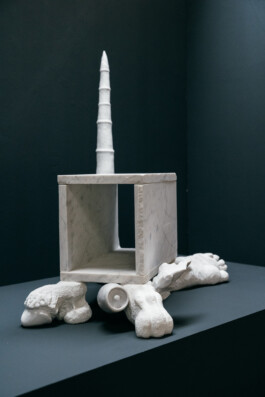







The two exhibitions, Cul-de-sac at Alte Tankstelle Deutz 29/05 -29/06, and Cul-2-sac at ICA 19/06-17/08 include the works of:
Golnesa Rezanezhad (IR–BE) presents a textile installation, titled Weaving the Past into the Present, in collaboration with local rug weavers from northern Iran, her land of origin, Through this work, she wants to subvert the stereotypical representations and perceptions about Middle Eastern women, especially Iranian women, often framed through a Western colonial lens as passive or oppressed, Through traditional craft practices, she highlights how the female weavers imagine and reflect their perceptions about their womanhood and their agency in transforming Iran’s visual heritage—resisting both state-driven heritage preservation and global demands for ‘authenticity' of Iranian carpet and the Iranian woman identity.
She also shows drawings that reflect the shifts brought about by Iran’s transition from an agricultural and craft-based economy to an oil-based one, This transformation deeply affected everyday life—reshaping relationships between people and nature, Within this context, women’s roles and daily practices have been significantly altered, questioned, and challenged.
Adler Murada's (BR-BE) contributes with a film and sculptural pieces that reflect his ongoing exploration from encounters with both human and non-human species, tracing a web of associations linked to language, exile, and childhood, In Parakeet Chronicles, Murada intertwines personal narratives with documentary elements to trace the presence of non-native parakeets in Brussels, The film operates as a poetic inquiry into themes of origin, migration, exoticism, and belonging—where fact and fabulation blur. Alongside the film, Murada presents sculptural works that echo the forms of nests, playgrounds, and shipping containers, using these structures as material metaphors to question captivity, adaptation, and shelter, Through gestures of mimicry, repetition, and interruption, the pieces explore the tension between the intimate and the estranged, the domestic and the displaced.
By pairing natural histories with personal ones, Murada’s work resonates with the exhibition’s question fixed binaries—guest and intruder, native and outsider, Rather than defining belonging, these works suggest a more fluid ecology of proximity and distance, where presence is constantly renegotiated, and even a fractured sound becomes a form of remembering.
Martijn Petrus’ (NL-BE) multidisciplinary practice plays with and comments on how we relate to the idea of nature, by researching topics like paleontology, queer ecology, interspecies kinship and contemporary lifestyle, The series of works made for the two exhibitions in Cologne, feature a strange combination of materials, Flower puzzles, built from colorful parts and sculptural elements built from mycelium, the threadlike network of fungi, The plastic flowers are loosely based on recognizable commercial varieties like orchids, hydrangeas and violas—standardized icons of beauty, desire and domestic exoticism, But these petrochemical flowers, despite their childlike innocence, are ghosts of the deep-time past and mirror the complex realities of the contemporary flower industry, Symbolizing our urge to control life and our relentless desire for beauty, cultivated flowers have become icons of human engineering: designed, bred, and grown to meet our ideals of perfection.
The collages "Protocols of desire (Dupes)" in the first exhibition show parts of the visually descriptive manuals from the toy-flowers, They have a similarity to scientific botanical illustrations, where plants and flowers are dissected and categorized into different elements in order to understand their inner workings and structure, Framing these artificial flowers, both with the collages as with the sculptures, are structures grown from mycelium, Fungi have become the latest addition to the list of eco-trends, celebrated as nature’s hidden heroes—healers, recyclers, connectors, But proposing them as the saviour of the planet is a method that once again takes away our personal responsibility to change the way we interact with our environment.
Mathias Prenen’s (BE) Industria series explores local material agency through the everyday and historical use of ceramics, Developed during a residency in Andalusia, Spain, the project was inspired by the region’s ceramic culture—where clay objects are common, functional, and made for durability and practicality.Collaborating with neighbours and sourcing and processing the clay directly from the land, the artist formed a direct, intuitive relationship with the material, uncovering its long-standing role in storing, directing, and generating both physical and spiritual energy.
In Undermining, Lucy Lippard writes: “The land carries stories as well as stones.”Using pierced and zip-tied ceramic forms, Industria becomes a semi-modular system that merges ancient knowledge with contemporary construction methods, It leans into the interpretive spirit of archaeology and proposes new ways of rebuilding knowledge and meaning through fragments, speculation, and play, This playful reconstruction resists fixed hierarchies and invites collective, imaginative engagement with the past and future, In doing so, the work speaks to decentralized ways of being, offering a material-based, relational approach that challenges rigid binaries and dominant narratives about progress and design, It celebrates the intelligence of materials and the everyday ingenuity found in local traditions, The photographs and ceramic constructions reflect on the tension between archaeological excavation and industrial extraction—one careful and interpretive, the other exploitative and utilitarian.
Maud Gourdon (FR-BE) constructs her Orgone Accumulators in accordance with the principles laid out by Austrian psychiatrist Wilhelm Reich (1897–1957), Rooted in historical controversy and metaphysical speculation, the orgone accumulator embodies a central paradox: a sealed, isolating structure conceived to attract and concentrate a universal life force — the elusive orgone, Positioned between scientific object and symbolic device, it interrogates the boundaries between knowledge and belief, legitimacy and taboo. Reich’s theories and inventions, long marginalized by mainstream science, have continued to resonate as forms of intellectual and political dissent, The orgone accumulator was conceived as a means to enable individuals to liberate themselves from societal repression and restore their natural vitality, which Reich viewed as intrinsically linked to sexuality, For Reich, sexual liberation was not merely personal but a political act, challenging societal control over sexuality, Within this context, the accumulator appears not only as a tool of speculation but also as a place where the contradictions of freedom are materially enacted.
Together, these works form a living archive—a collective, open-ended narrative that resists closure. The exhibition does not offer solutions but rather proposes gestures of interdependence, it asks: What tools do we carry in our shared carrier bag? How might we gather, not to dominate or resolve, but to sustain, share, and reimagine?
In Kollaboration mit Level Five (Brüssel) & Alte Tankstelle Deutz (Köln)
mit freundlicher Unterstützung druch
Stadt Köln, Kulturamt – Flanders, State of the Art
Die beiden Ausstellungen Cul-de-sac in der Alten Tankstelle Deutz (29/05 - 29/06) und Cul-2-sac im ICA (19/06 - 17/08) umfassen Werke von:
Golnesa Rezanezhad (IR-BE) präsentiert eine Textilinstallation mit dem Titel Weaving the Past into the Present (Weben der Vergangenheit in die Gegenwart), die sie in Zusammenarbeit mit lokalen Teppichweberinnen aus dem Nordiran, ihrem Herkunftsland, geschaffen hat. Mit dieser Arbeit möchte sie die stereotypen Darstellungen und Wahrnehmungen über Frauen im Nahen Osten, insbesondere iranische Frauen, untergraben, die oft durch eine westliche koloniale Linse als passiv oder unterdrückt dargestellt werden, Anhand traditioneller Handwerkspraktiken zeigt sie auf, wie sich die Knüpferinnen ihre Vorstellungen von ihrem Frausein vorstellen und reflektieren und wie sie das visuelle Erbe des Irans umgestalten - und sich dabei sowohl der staatlich verordneten Denkmalpflege als auch den globalen Forderungen nach „Authentizität“ des iranischen Teppichs und der Identität der iranischen Frau widersetzen.
Sie zeigt auch Zeichnungen, die die Veränderungen widerspiegeln, die der Übergang des Irans von einer landwirtschaftlichen und handwerklichen Wirtschaft zu einer erdölbasierten Wirtschaft mit sich brachte. Dieser Wandel hatte tiefgreifende Auswirkungen auf das tägliche Leben und veränderte die Beziehungen zwischen Mensch und Natur.
Adler Muradas (BR-BE) Beitrag besteht aus einem Film und skulpturalen Arbeiten, die seine fortwährende Erforschung von Begegnungen mit menschlichen und nicht-menschlichen Spezies widerspiegeln und ein Netz von Assoziationen aufspüren, die mit Sprache, Exil und Kindheit verbunden sind. In Parakeet Chronicles verwebt Murada persönliche Erzählungen mit dokumentarischen Elementen, um die Anwesenheit von nicht-einheimischen Sittichen in Brüssel nachzuzeichnen.
Parallel zum Film präsentiert Murada skulpturale Arbeiten, die die Formen von Nestern, Spielplätzen und Schiffscontainern aufgreifen und diese Strukturen als materielle Metaphern nutzen, um Gefangenschaft, Anpassung und Schutz zu hinterfragen. Durch Gesten der Mimikry, Wiederholung und Unterbrechung erkunden die Arbeiten die Spannung zwischen dem Vertrauten und dem Entfremdeten, dem Heimischen und dem Vertriebenen.
Indem Muradas Arbeiten natürliche Geschichten mit persönlichen Geschichten verbinden, schwingen sie mit der Frage nach festen Binaritäten - Gast und Eindringling, Einheimischer und Außenseiter - mit, die die Ausstellung aufwirft. Statt Zugehörigkeit zu definieren, suggerieren diese Arbeiten eine fließende Ökologie von Nähe und Distanz, in der Präsenz ständig neu verhandelt wird und selbst ein gebrochener Klang zu einer Form der Erinnerung wird.
Martijn Petrus' (NL-BE) multidisziplinäre Praxis spielt mit und kommentiert, wie wir uns zur Idee der Natur verhalten, indem er Themen wie Paläontologie, Queer-Ökologie, Interspezies-Verwandtschaft und zeitgenössischen Lebensstil erforscht. Die Serie von Arbeiten, die für die beiden Ausstellungen in Köln entstanden sind, weist eine seltsame Kombination von Materialien auf: Blumenpuzzle aus bunten Teilen und skulpturale Elemente, die aus Mycelium, dem fadenförmigen Netzwerk von Pilzen, gebaut sind, Die Plastikblumen basieren lose auf bekannten kommerziellen Sorten wie Orchideen, Hortensien und Veilchen - standardisierte Ikonen der Schönheit, der Sehnsucht und der häuslichen Exotik. Aber diese petrochemischen Blumen sind trotz ihrer kindlichen Unschuld Gespenster einer längst vergangenen Zeit und spiegeln die komplexen Realitäten der heutigen Blumenindustrie wider: Sie wurden entworfen, gezüchtet und angebaut, um unseren Idealen von Perfektion zu entsprechen.
Die Collagen „Protocols of desire (Dupes)“ in der ersten Ausstellung zeigen Teile der visuell beschreibenden Handbücher der Spielzeugblumen. Sie haben eine Ähnlichkeit mit wissenschaftlichen botanischen Illustrationen, bei denen Pflanzen und Blumen seziert und in verschiedene Elemente kategorisiert werden, um ihr Innenleben und ihre Struktur zu verstehen, Sowohl bei den Collagen als auch bei den Skulpturen rahmen Strukturen aus Pilzmyzel diese künstlichen Blumen ein. Pilze sind der jüngste Neuzugang auf der Liste der Öko-Trends, die als verborgene Helden der Natur gefeiert werden - als Heiler, Recycler, Verbinder... Aber sie als Retter des Planeten vorzuschlagen, ist eine Methode, die uns wieder einmal die persönliche Verantwortung dafür abnimmt, wie wir mit unserer Umwelt umgehen.
Mathias Prenens (BE) Industria-Serie erforscht die lokale Materialkompetenz durch die alltägliche und historische Verwendung von Keramik. Das Projekt entstand während eines Aufenthalts in Andalusien, Spanien, und wurde von der dortigen Keramikkultur inspiriert, in der Tonobjekte alltäglich, funktional und auf Langlebigkeit und Zweckmäßigkeit ausgelegt sind. Durch die Zusammenarbeit mit Nachbarn und die Beschaffung und Verarbeitung des Tons direkt vor Ort baute der Künstler eine direkte, intuitive Beziehung zu dem Material auf und entdeckte dessen langjährige Rolle bei der Speicherung, Lenkung und Erzeugung von körperlicher und geistiger Energie.
In Undermining schreibt Lucy Lippard: "The land carries stories as well as stones." Es lehnt sich an den interpretierenden Geist der Archäologie an und schlägt neue Wege vor, Wissen und Bedeutung durch Fragmente, Spekulationen und Spiel wiederherzustellen. Diese spielerische Rekonstruktion widersetzt sich festen Hierarchien und lädt zu einer kollektiven, fantasievollen Auseinandersetzung mit der Vergangenheit und der Zukunft ein, indem sie Die Arbeit spricht dabei dezentralisierte Seinsweisen an und bietet einen materialbasierten, relationalen Ansatz, der starre Binaritäten und vorherrschende Erzählungen über Fortschritt und Design in Frage stellt. Sie feiert die Intelligenz von Materialien und den alltäglichen Einfallsreichtum, der in lokalen Traditionen zu finden ist. Die Fotografien und keramischen Konstruktionen reflektieren die Spannung zwischen archäologischen Ausgrabungen und industrieller Gewinnung - die eine sorgfältig und interpretierend, die andere ausbeuterisch und utilitaristisch.
Maud Gourdon (FR-BE) konstruiert ihre Orgon-Akkumulatoren nach den Grundsätzen des österreichischen Psychiaters Wilhelm Reich (1897-1957). Der Orgon-Akkumulator, der in historischen Kontroversen und metaphysischen Spekulationen wurzelt, verkörpert ein zentrales Paradoxon: eine versiegelte, isolierende Struktur, die eine universelle Lebenskraft - das schwer fassbare Orgon - anziehen und konzentrieren soll, und die zwischen wissenschaftlichem Objekt und symbolischem Gerät angesiedelt ist und die Grenzen zwischen Wissen und Glauben, Legitimität und Tabu hinterfragt.
Reichs Theorien und Erfindungen, die lange Zeit von der Mainstream-Wissenschaft an den Rand gedrängt wurden, haben als Formen des intellektuellen und politischen Dissenses weiter Resonanz gefunden. Der Orgon-Akkumulator wurde als Mittel konzipiert, das es dem Einzelnen ermöglicht, sich von gesellschaftlicher Unterdrückung zu befreien und seine natürliche Vitalität wiederherzustellen, Für Reich war die sexuelle Befreiung nicht nur ein persönlicher, sondern auch ein politischer Akt, der die gesellschaftliche Kontrolle über die Sexualität in Frage stellte. In diesem Kontext erscheint der Akkumulator nicht nur als ein Werkzeug der Spekulation, sondern auch als ein Ort, an dem die Widersprüche der Freiheit materiell umgesetzt werden.
Zusammen bilden diese Werke ein lebendiges Archiv - eine kollektive Erzählung mit offenem Ende, die sich einem Abschluss widersetzt. Die Ausstellung bietet keine Lösungen an, sondern schlägt vielmehr Gesten der Interdependenz vor, sie fragt: Welche Werkzeuge tragen wir in unserer gemeinsamen Tragetasche? Wie können wir uns versammeln, nicht um zu dominieren oder zu lösen, sondern um zu erhalten, zu teilen und neu zu erfinden?
In Kollaboration mit Level Five (Brüssel) & Alte Tankstelle Deutz (Köln)
mit freundlicher Unterstützung druch
Stadt Köln, Kulturamt – Flanders, State of the Art
The two exhibitions, Cul-de-sac at Alte Tankstelle Deutz 29/05 -29/06, and Cul-2-sac at ICA 19/06-17/08 include the works of:
Golnesa Rezanezhad (IR–BE) presents a textile installation, titled Weaving the Past into the Present, in collaboration with local rug weavers from northern Iran, her land of origin, Through this work, she wants to subvert the stereotypical representations and perceptions about Middle Eastern women, especially Iranian women, often framed through a Western colonial lens as passive or oppressed, Through traditional craft practices, she highlights how the female weavers imagine and reflect their perceptions about their womanhood and their agency in transforming Iran’s visual heritage—resisting both state-driven heritage preservation and global demands for ‘authenticity' of Iranian carpet and the Iranian woman identity.
She also shows drawings that reflect the shifts brought about by Iran’s transition from an agricultural and craft-based economy to an oil-based one, This transformation deeply affected everyday life—reshaping relationships between people and nature, Within this context, women’s roles and daily practices have been significantly altered, questioned, and challenged.
Adler Murada's (BR-BE) contributes with a film and sculptural pieces that reflect his ongoing exploration from encounters with both human and non-human species, tracing a web of associations linked to language, exile, and childhood, In Parakeet Chronicles, Murada intertwines personal narratives with documentary elements to trace the presence of non-native parakeets in Brussels, The film operates as a poetic inquiry into themes of origin, migration, exoticism, and belonging—where fact and fabulation blur. Alongside the film, Murada presents sculptural works that echo the forms of nests, playgrounds, and shipping containers, using these structures as material metaphors to question captivity, adaptation, and shelter, Through gestures of mimicry, repetition, and interruption, the pieces explore the tension between the intimate and the estranged, the domestic and the displaced.
By pairing natural histories with personal ones, Murada’s work resonates with the exhibition’s question fixed binaries—guest and intruder, native and outsider, Rather than defining belonging, these works suggest a more fluid ecology of proximity and distance, where presence is constantly renegotiated, and even a fractured sound becomes a form of remembering.
Martijn Petrus’ (NL-BE) multidisciplinary practice plays with and comments on how we relate to the idea of nature, by researching topics like paleontology, queer ecology, interspecies kinship and contemporary lifestyle, The series of works made for the two exhibitions in Cologne, feature a strange combination of materials, Flower puzzles, built from colorful parts and sculptural elements built from mycelium, the threadlike network of fungi, The plastic flowers are loosely based on recognizable commercial varieties like orchids, hydrangeas and violas—standardized icons of beauty, desire and domestic exoticism, But these petrochemical flowers, despite their childlike innocence, are ghosts of the deep-time past and mirror the complex realities of the contemporary flower industry, Symbolizing our urge to control life and our relentless desire for beauty, cultivated flowers have become icons of human engineering: designed, bred, and grown to meet our ideals of perfection.
The collages "Protocols of desire (Dupes)" in the first exhibition show parts of the visually descriptive manuals from the toy-flowers, They have a similarity to scientific botanical illustrations, where plants and flowers are dissected and categorized into different elements in order to understand their inner workings and structure, Framing these artificial flowers, both with the collages as with the sculptures, are structures grown from mycelium, Fungi have become the latest addition to the list of eco-trends, celebrated as nature’s hidden heroes—healers, recyclers, connectors, But proposing them as the saviour of the planet is a method that once again takes away our personal responsibility to change the way we interact with our environment.
Mathias Prenen’s (BE) Industria series explores local material agency through the everyday and historical use of ceramics, Developed during a residency in Andalusia, Spain, the project was inspired by the region’s ceramic culture—where clay objects are common, functional, and made for durability and practicality.Collaborating with neighbours and sourcing and processing the clay directly from the land, the artist formed a direct, intuitive relationship with the material, uncovering its long-standing role in storing, directing, and generating both physical and spiritual energy.
In Undermining, Lucy Lippard writes: “The land carries stories as well as stones.”Using pierced and zip-tied ceramic forms, Industria becomes a semi-modular system that merges ancient knowledge with contemporary construction methods, It leans into the interpretive spirit of archaeology and proposes new ways of rebuilding knowledge and meaning through fragments, speculation, and play, This playful reconstruction resists fixed hierarchies and invites collective, imaginative engagement with the past and future, In doing so, the work speaks to decentralized ways of being, offering a material-based, relational approach that challenges rigid binaries and dominant narratives about progress and design, It celebrates the intelligence of materials and the everyday ingenuity found in local traditions, The photographs and ceramic constructions reflect on the tension between archaeological excavation and industrial extraction—one careful and interpretive, the other exploitative and utilitarian.
Maud Gourdon (FR-BE) constructs her Orgone Accumulators in accordance with the principles laid out by Austrian psychiatrist Wilhelm Reich (1897–1957), Rooted in historical controversy and metaphysical speculation, the orgone accumulator embodies a central paradox: a sealed, isolating structure conceived to attract and concentrate a universal life force — the elusive orgone, Positioned between scientific object and symbolic device, it interrogates the boundaries between knowledge and belief, legitimacy and taboo. Reich’s theories and inventions, long marginalized by mainstream science, have continued to resonate as forms of intellectual and political dissent, The orgone accumulator was conceived as a means to enable individuals to liberate themselves from societal repression and restore their natural vitality, which Reich viewed as intrinsically linked to sexuality, For Reich, sexual liberation was not merely personal but a political act, challenging societal control over sexuality, Within this context, the accumulator appears not only as a tool of speculation but also as a place where the contradictions of freedom are materially enacted.
Together, these works form a living archive—a collective, open-ended narrative that resists closure. The exhibition does not offer solutions but rather proposes gestures of interdependence, it asks: What tools do we carry in our shared carrier bag? How might we gather, not to dominate or resolve, but to sustain, share, and reimagine?
In Kollaboration mit Level Five (Brüssel) & Alte Tankstelle Deutz (Köln)
mit freundlicher Unterstützung druch
Stadt Köln, Kulturamt – Flanders, State of the Art